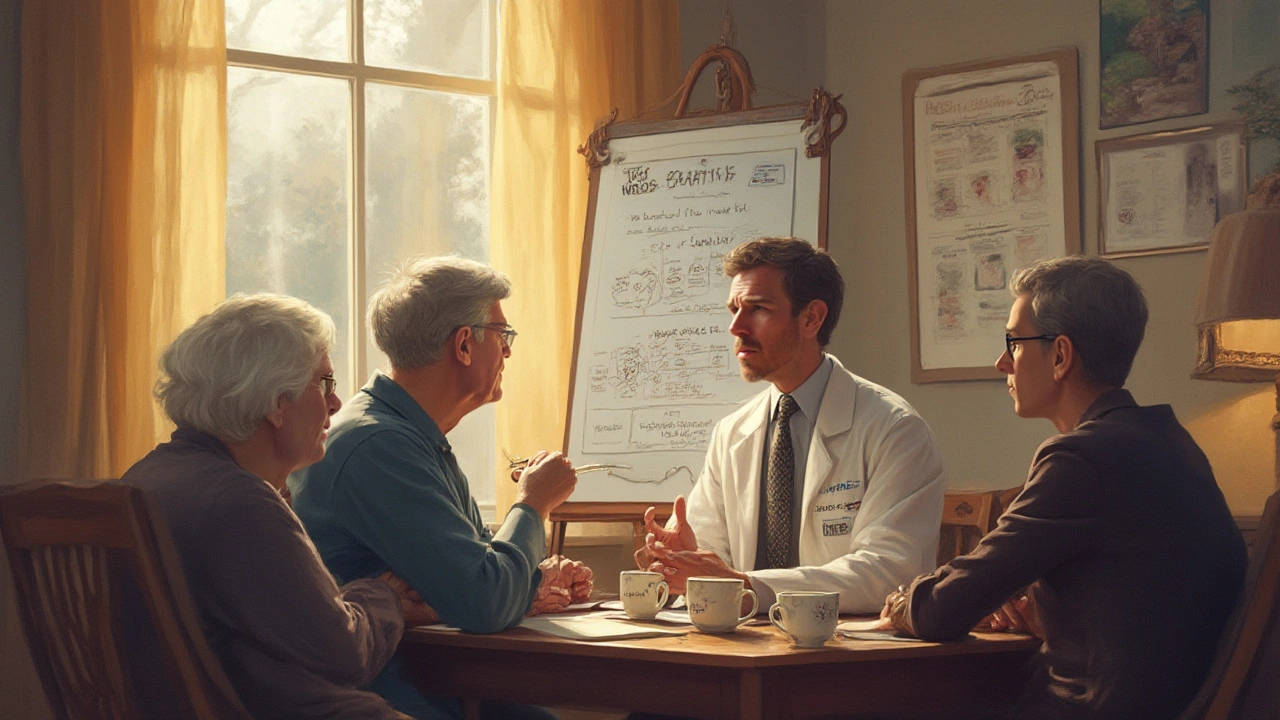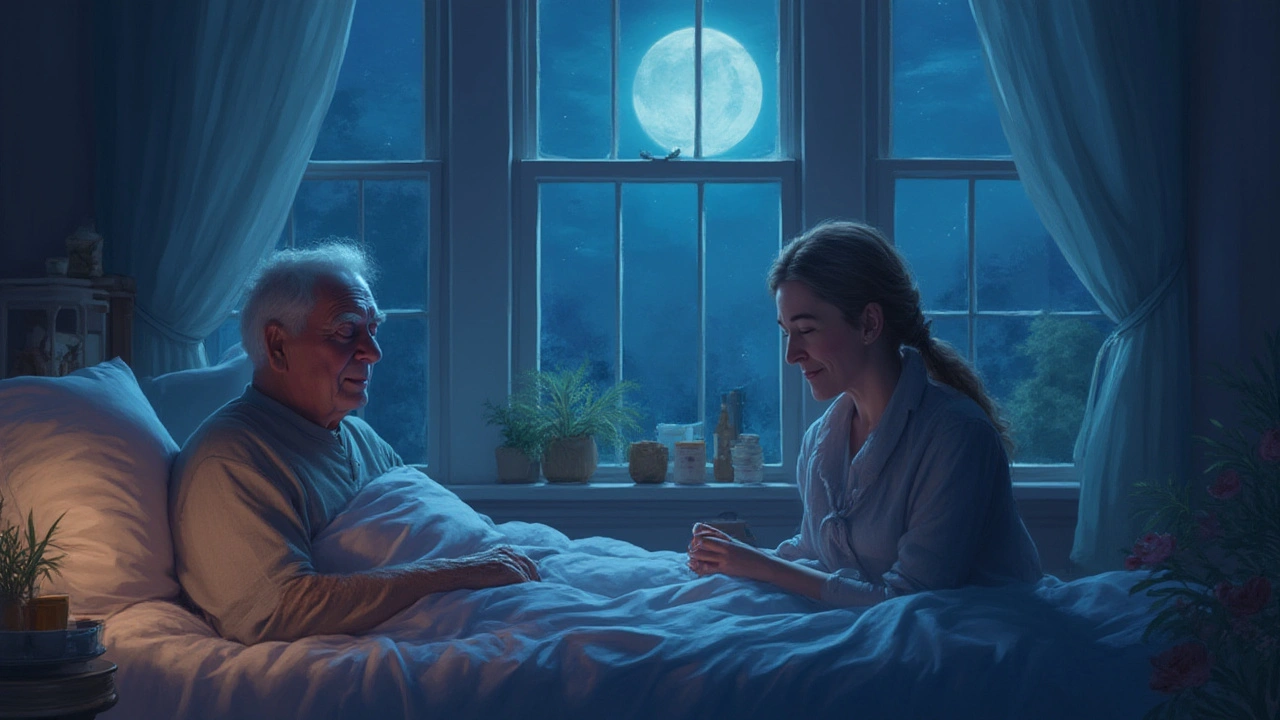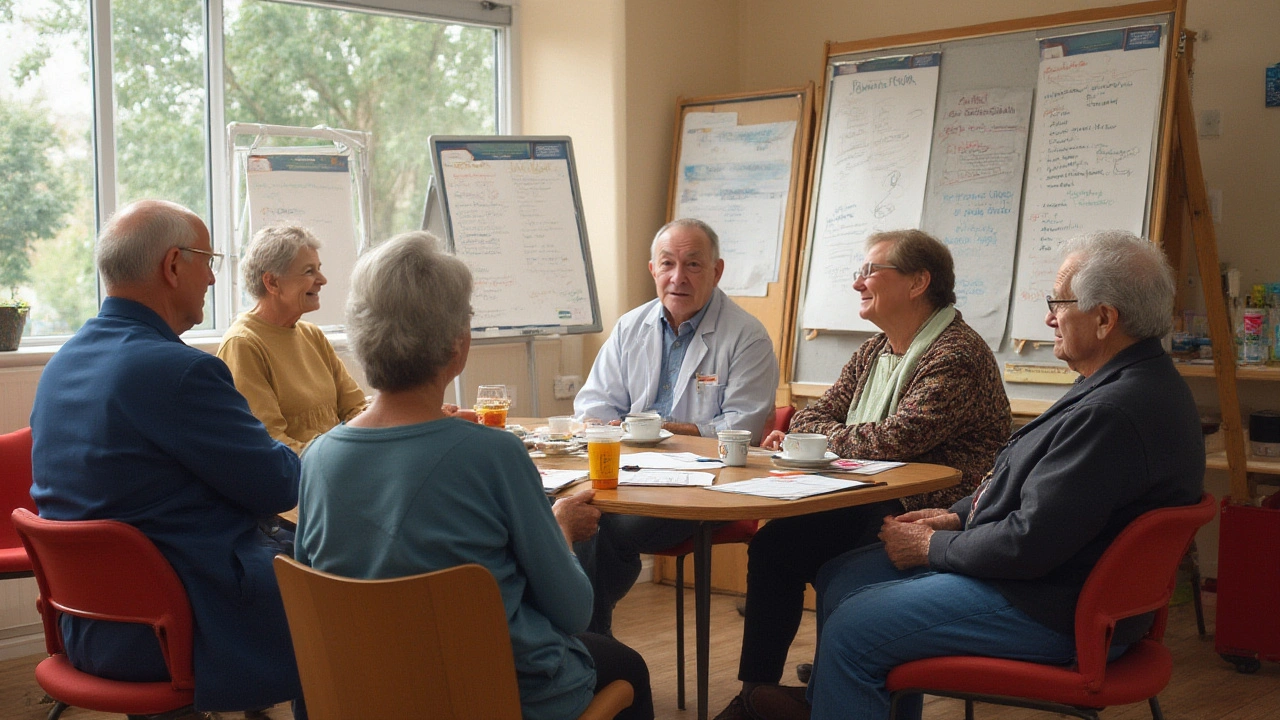
Restlessness, vivid dreams, yelling, and even falling out of bed—these are not just eerie tales from the night but regular events in the lives of many people with Parkinson’s. If you’ve ever watched a loved one thrash around in sleep, it hits differently than a standard bout of insomnia. For people with Parkinson’s, sleep is never as simple as closing your eyes and drifting off. There’s a constant effort to find rest, and that search drags on quietly, night after night. Trazodone, a humble antidepressant, has become one of the interesting players in this frustrating routine. But what’s the real deal with it? Does it truly help sleep in Parkinson’s—or is it just another prescription slip that sits half empty next to the bed?
How Parkinson’s Messes with Sleep (and Where Trazodone Slots In)
No one prepares you for how Parkinson’s will ambush the night. You might picture the classic hand tremor, the slow walk—but sleep? The problem is, dopamine (the chemical that tanks in Parkinson’s) isn’t just about movement. It plays a key role in the brain’s internal clock and sleep cycles. Because of that, a Parkinson’s brain can barely tell day from night, giving you days of grogginess and nights full of crazy dreams or even vivid nightmares. Oh, and that dream where you’re falling? Some folks act it out—literally! REM sleep behavior disorder (RBD) means the body loses its natural sleep paralysis, so people punch, kick, or talk out their dreams. Wives joke about needing helmets, but honestly, no one is laughing when you end up on the floor at 2 a.m.
Now, enter trazodone. On the surface, it doesn’t look special. It was first cooked up in the 1960s as an antidepressant, and it never gained traction there. But here’s the twist—it makes people sleepy, and that drowsiness side effect led neurologists to test it out when the usual sleep meds failed. Trazodone works by blocking certain brain chemicals, which calms racing thoughts and slows down the chatter upstairs. Unlike classic sleeping pills (think z-drugs like zolpidem), it doesn’t tank your breathing or leave you feeling like you’ve been run over the next morning. Hospitals hand out trazodone for sleep left and right—especially to folks who are on a pile of other meds already.
You do get stories of people with Parkinson’s who claim trazodone is the only thing that lets them sleep longer than two hours at a stretch. The doses used for sleep are much lower—25mg to 100mg, usually at night. Some docs go as low as 12.5mg. But every neurologist has their own take. Dr. Nina Catterson in Bath told me that low doses “can really take the edge off nighttime restlessness.” The risk? If you’re wobbly on your feet already, trazodone can cause just enough grogginess to increase stumbles on those midnight bathroom trips. In older folks, it might also trigger wild dreams or leave you confused first thing in the morning.
But here’s a perk worth knowing: trazodone isn’t addictive, and it doesn’t tank your REM sleep. That’s critical in Parkinson’s because you can’t afford to lose REM—the stage where you form memories and shake off the grime of the day. Even more interesting, trazodone may gently nudge the body back toward a more natural “sleep-wake” cycle, though nobody fully understands why. There’s real talk among neurologists about how it stacks up compared to drugs like temazepam or z-drugs that disrupt your sleep phases much more aggressively.

REM Behavior Disorder: Trazodone’s Role and Alternatives
When it comes to REM behavior disorder—where you literally fight your dreams—most neurologists reach for drugs like clonazepam or melatonin first. Here’s the awkward bit: both of those can leave you groggy too, and clonazepam carries a heavy risk of falls and memory problems, especially as you get older. Melatonin sounds harmless since your brain makes it naturally, but in Parkinson’s patients, even high doses sometimes fall flat.
Trazodone does show up as a second-string choice in the guidelines for RBD, but the evidence is patchy. In smaller clinical reports, patients with Parkinson’s taking trazodone had fewer violent outbursts at night, and their partners noticed less chaos in bed. Still, it’s not a slam dunk. Some patients saw a reduction in movement but became more prone to nightmares. One solid advantage is trazodone’s gentler morning “hangover” and its flexibility in dose. For the practical bit—doctors usually start very low and nudge up slowly, watching for morning brain fog and any slips or stumbles.
If trazodone isn’t a good fit, what else is on the shelf? There are a few options:
- Melatonin: Start with 2-5mg at night. Higher doses only if your doctor says so. Don’t expect miracles, but you may get 30-60 extra minutes of solid sleep.
- Clonazepam: Reserved for desperate cases due to side effects. Half a tablet or less is usually enough; watch for falls.
- Pimavanserin: Not common outside the US, but it’s an option for those with Parkinson’s psychosis and sleep issues.
- Physical stuff: Locking up bedrooms, putting pillows on the floor, and using bed alarms. Some people go so far as to sleep in separate beds just to survive until breakfast.
- Sleep hygiene: Boring but underrated. Stick to a wakeup time, get outside in the morning, cut caffeine after midday, and ban screens an hour before sleep. And yes, this applies even if your loved one is 80 and rolling their eyes at the idea.
The uncomfortable truth: even the best drugs rarely solve REM behavior disorder completely. Most patients end up piecing together several fixes—tweaking meds, changing sleep setups, and using just enough medicine to tame chaos without sabotaging the daytime hours. And sometimes, as partners will tell you, a weighted blanket can feel more useful than the fanciest prescription on the market.

Neurologist Commentary: Dosing, Real-Life Experience, and When Trazodone Works Best
Ask a handful of neurologists about dosing trazodone for Parkinson’s-related sleep, and you’ll get a sliding scale. The sweet spot for most people is between 25mg and 75mg at bedtime. Go higher, and you risk daytime grogginess; go too low, and you might as well be swallowing a tic-tac. A neurologist in Bristol, Dr. Harish Venkataramani, pointed out recently, “For my frailest patients, even half a 25mg tablet can take the edge off insomnia without making them zombies.” But this isn’t one-size-fits-all stuff. Older adults metabolize trazodone slower, so a dose that’s perfect for a 50-year-old might linger too long in someone’s system at 80.
One clever approach some Bristol clinics are using: dose-splitting. Instead of 50mg at once, they give 25mg, wait an hour, and offer another 25mg only if the person is still wide awake. Keeps side effects down and makes people feel a little more in control of their bedtime fate. Others will cycle trazodone for a few days on, a few days off—just to avoid tolerance and keep its sedative punch working.
In the real world, families care less about sleep efficiency data and more about whether Dad actually makes it through the night without yelling, thrashing, or endless trips to the loo. The single best tip from families who’ve been there? Keep a sleep diary—write down not just how your loved one slept, but what else happened that day: exercise, caffeine, time outdoors, and stress. Neurologists in the know swear by these records to fine-tune dosing and spot patterns that no pill can fix.
Of course, medication is just part of the fix. Exercise is more than a daytime pastime for Parkinson’s—it does wonders for sleep. University of Bristol studies found that 20-30 minutes of brisk walking before 6 p.m. led to better sleep in Parkinson’s, even when meds didn’t change. Tiny diet tweaks matter, too: avoid big evening meals, limit fluids close to bedtime, and skip the nightcap, since alcohol messes with sleep cycles worse than any drug.
It’s easy to lose hope when the sleep struggles grind on, but there’s a slowly growing set of tools. If you want a good, straightforward breakdown of trazodone for Parkinson's sleep problems, this recent post at trazodone for Parkinson's sleep problems runs through options and specifics recommended by sleep specialists who do this daily.
Here’s the unvarnished truth: there’s no magic pill for Parkinson’s sleep problems, and every case is different. But trazodone deserves its spot in the toolkit. It offers enough sleepiness to get through rough patches, isn’t addictive, and can be tailored dose by dose. For some, it’s the difference between a night of chaos and a few blessed hours of quiet. The goal is never perfect sleep—that’s a fantasy with Parkinson’s. The real win is getting just enough rest to face tomorrow, with as little collateral damage as possible.

Let’s be real-trazodone is just the pharmaceutical industry’s way of masking the fact that we’ve been poisoning our sleep architecture with EMFs, glyphosate, and fluoride-laced tap water for decades. Neurologists? They’re paid by Big Pharma to pretend this is science. The real fix? Grounding mats, red light therapy, and cutting out all blue light after 5 p.m. I’ve seen patients go from screaming in REM to sleeping like babies-no pills, just biohacking. Trazodone’s just a Band-Aid on a bullet wound.
And don’t get me started on melatonin. Your body makes it from serotonin, which comes from tryptophan, which requires magnesium and B6-nutrients most people are deficient in because of soil depletion. So no, you can’t just pop a pill and fix systemic nutritional collapse. Wake up.
They don’t want you to know this. But if you’re reading this, you’re already one step ahead.
As someone from India whose father has Parkinson’s, I’ve seen both sides. We tried trazodone-low dose, 25mg-and it helped him sleep without the morning fog that clonazepam gave him. But what helped more? A warm milk drink with turmeric before bed, a fan blowing gently, and his favorite devotional music playing softly. No one talks about these things in Western clinics.
Maybe the answer isn’t just one drug. Maybe it’s culture, rhythm, quiet. Trazodone? Fine. But don’t forget the human touch. We used to treat sleep as sacred-not a problem to be dosed.
I’ve been caring for my uncle with Parkinson’s for five years. Trazodone was the first thing that actually gave us three hours of quiet sleep. No yelling, no kicking. His wife cried when she saw him lie still.
But here’s the thing-we also started walking together every morning at 7, no matter the weather. And we stopped giving him coffee after noon. Simple stuff. The trazodone didn’t fix everything, but it gave us breathing room to fix the rest.
Don’t overcomplicate it. Sometimes the best medicine is consistency, not chemistry.
While trazodone demonstrates a favorable pharmacodynamic profile in modulating 5-HT2A receptor antagonism, thereby attenuating cortical hyperarousal without significant suppression of REM architecture-a critical consideration in Parkinson’s disease given the neurodegenerative cascade affecting the pontine tegmentum-it is imperative to acknowledge the heterogeneity of pharmacokinetic responses across geriatric populations.
Studies by the Movement Disorder Society (2021) indicate a 37% reduction in RBD event frequency at 50mg nightly, with a narrow therapeutic window (25–75mg) due to age-related declines in hepatic CYP3A4 metabolism. The absence of GABAergic activity distinguishes it from benzodiazepines, thereby reducing fall risk by approximately 22% in cohort analyses.
However, the clinical utility remains contingent upon concomitant medication review, particularly in polypharmacy regimens involving MAO-B inhibitors or dopamine agonists, where additive sedative effects may potentiate orthostatic hypotension.
Recommendation: titrate slowly, monitor morning cognitive latency via MoCA, and correlate with actigraphy data. No substitute for objective sleep architecture analysis.
My mom’s been on 25mg for six months. She doesn’t scream anymore. That’s all I needed to know.